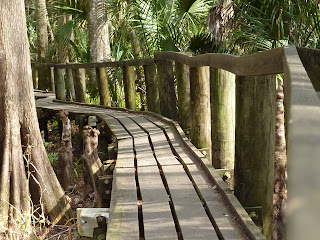Located in the geographic center of peninsular Florida, Highlands Hammock State Park is a treasure trove of biodiversity. At 9000 acres, it is one of Florida’s smaller parks. But what it lacks in size, it makes up in flora variety. Over 700 different species of vascular plants live here. Nine different hiking trails, over four miles in total length, take one thru pine flatwoods, , a pop-ash slough (slow moving shallow creek), a blackwater cypress swamp, and a live oak/cabbage palm hammock. (In Florida, the word hammock refers to a fertile, wooded area that is at a slightly higher elevation than the nearby marshes and swamps. It comes from the word hummock or hillock.)
After driving from Venice for two hours, through mainly cattle ranches and citrus groves, in apparently the middle of nowhere, I found the park entrance. I paid the four dollar entrance fee and proceeded around the three mile paved road thru the park.
First stop was to see the 1000 year old live oak growing at the trailhead of the Big Oak Trail. Advertised as the oldest living thing in the park, it was a little disappointing. While the base circumference truly was a whopping 36 feet, the top, above about 15 feet, had been destroyed by storms, and was replaced by much younger growth.
 |
| 1000 Yr Old Live Oak |
Thankfully, further along the trail, there were much healthier specimens, with the classic spreading fern and moss covered branches extending 100 feet from the main trunk. Because of this horizontal spread, it is impossible to photograph these giants. They must be seen. But, here’s a shot of the oak canopy showing the silver Spanish moss glistening in the filtered sunlight.
Next I wanted to hike the Cypress Swamp Trail. This half mile trail meanders over the shallow water on a narrow and somewhat primitive boardwalk.
 |
| Ogeechee Tupelo |
Cypress and Tupelo tress dominate the swamp. Since we are into the winter dry season, the water level was low and the cypress knees were standing erect in the peat bottom like sentries on guard. Knees are vertical growths from the shallow root system. The purpose of these knees is debated. The favored theory is that due to the very soft and porous soil, they provide an added support for the towering main trunk.
 |
| Cypress Knees |
Because it was winter and the middle of the day, the wildlife viewing was minimal. So I decided to concentrate on the park’s main attraction, plants. Since plants don’t run from you when you approach, one can get as close as he wants, identify the species, compose the photograph, and take as many shots as needed…quite different from wildlife photography.Since the park is home to more than 30 species of ferns, I made it my goal to identify and photograph as many as possible. Ferns are one of the oldest groups of plants, with fossils found from 360 million years ago. They reproduce asexually, by releasing thousands of tiny pores from the underside of their fronds. The Giant Leather Fern, which can grow to a staggering 13 feet, is threatened and found only in Florida. I wonder if I could be so lucky.
I ventured on to the Ancient Hammock Trail and the aptly named, Fern Garden Trail. Ferns are easy to spot and I quickly identified Boston Ferns, Marsh Ferns, and small Sword Ferns growing up from the moist soil.
 |
| Boston Fern |
 |
| Marsh Ferns |
 |
| Sword Ferns |
But many ferns are epiphytic and grow on trees without the benefit of soil. I found beautiful specimens of Strap Ferns growing on Live Oak trunks and Shoestring Ferns growing on Cabbage Palms. A most amazing fern is the Resurrection Fern, named for its ability to sustain severe droughts by shriveling and turning brown, and then “resurrecting” with the onset of rain.
 |
| Strap Ferns |
 |
| Shoestring Ferns |
 |
| Resurection Ferns |
Along the way, I noticed wild coffee with its distinctive bright red berries growing next to the trail and sour orange trees seeming out of place in the thick underbrush.
Near the end of the trail, I noticed some larger ferns growing well off the path. Could it be? Closer inspection did indeed prove them to be young Giant Leather Ferns (“only” about 5 feet high).
 |
| Giant Leather Ferns |
At the end of the day, with seven species identified, I was off to a good start. Florida has 123 species of ferns, more than any other state, but Hawaii. So identifying these mysterious creatures could keep me very, very busy.













